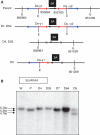Transposon Ac/Ds-induced chromosomal rearrangements at the rice OsRLG5 locus
- PMID: 21965541
- PMCID: PMC3239180
- DOI: 10.1093/nar/gkr718
Transposon Ac/Ds-induced chromosomal rearrangements at the rice OsRLG5 locus
Abstract
Previous studies have shown that pairs of closely-linked Ac/Ds transposable elements can induce various chromosomal rearrangements in plant genomes. To study chromosomal rearrangements in rice, we isolated a line (OsRLG5-161) that contains two inversely-oriented Ds insertions in OsRLG5 (Oryza sativa Receptor like kinase Gene 5). Among approximately 300 plants regenerated from OsRLG5-161 heterozygous seeds, 107 contained rearrangements including deletions, duplications and inversions of various sizes. Most rearrangements were induced by previously identified alternative transposition mechanism. Furthermore, we also detected a new class of rearrangements that contain juxtaposed inversions and deletions on the same chromosome. We propose that these novel alleles were generated by a previously unreported type of alternative transposition reactions involving the 5' and 3' termini of two inversely-oriented Ds elements located on the same chromatid. Finally, 11% of rearrangements contained inversions resulting from homologous recombination between the two inverted Ds elements in OsRLG5-161. The high frequency inheritance and great variety of rearrangements obtained suggests that the rice regeneration system results in a burst of transposition activity and a relaxation of the controls which normally limit the transposition competence of individual Ds termini. Together, these results demonstrate a greatly enlarged potential of the Ac/Ds system for plant chromosome engineering.
© The Author(s) 2011. Published by Oxford University Press.
Figures








Similar articles
-
A transgenic system for generation of transposon Ac/Ds-induced chromosome rearrangements in rice.Theor Appl Genet. 2012 Nov;125(7):1449-62. doi: 10.1007/s00122-012-1925-4. Epub 2012 Jul 14. Theor Appl Genet. 2012. PMID: 22798058 Free PMC article.
-
Generation and Analysis of Transposon Ac/Ds-Induced Chromosomal Rearrangements in Rice Plants.Methods Mol Biol. 2016;1469:49-61. doi: 10.1007/978-1-4939-4931-1_4. Methods Mol Biol. 2016. PMID: 27557685
-
Ac/Ds-induced chromosomal rearrangements in rice genomes.Mob Genet Elements. 2012 Mar 1;2(2):67-71. doi: 10.4161/mge.20264. Mob Genet Elements. 2012. PMID: 22934239 Free PMC article.
-
Transposon tagging in rice.Plant Mol Biol. 1997 Sep;35(1-2):219-29. Plant Mol Biol. 1997. PMID: 9291975 Review.
-
Genome juggling by transposons: Tam3-induced rearrangements in Antirrhinum majus.Dev Genet. 1989;10(6):438-51. doi: 10.1002/dvg.1020100605. Dev Genet. 1989. PMID: 2557989 Review.
Cited by
-
Transposon-mediated telomere destabilization: a driver of genome evolution in the blast fungus.Nucleic Acids Res. 2020 Jul 27;48(13):7197-7217. doi: 10.1093/nar/gkaa287. Nucleic Acids Res. 2020. PMID: 32558886 Free PMC article.
-
A transgenic system for generation of transposon Ac/Ds-induced chromosome rearrangements in rice.Theor Appl Genet. 2012 Nov;125(7):1449-62. doi: 10.1007/s00122-012-1925-4. Epub 2012 Jul 14. Theor Appl Genet. 2012. PMID: 22798058 Free PMC article.
-
Investigation and Computational Analysis of the Sulfotransferase (SOT) Gene Family in Potato (Solanum tuberosum): Insights into Sulfur Adjustment for Proper Development and Stimuli Responses.Plants (Basel). 2021 Nov 26;10(12):2597. doi: 10.3390/plants10122597. Plants (Basel). 2021. PMID: 34961068 Free PMC article.
-
Generation of tandem direct duplications by reversed-ends transposition of maize ac elements.PLoS Genet. 2013;9(8):e1003691. doi: 10.1371/journal.pgen.1003691. Epub 2013 Aug 15. PLoS Genet. 2013. PMID: 23966872 Free PMC article.
-
Telomere-to-Telomere Genome Sequences across a Single Genus Reveal Highly Variable Chromosome Rearrangement Rates but Absolute Stasis of Chromosome Number.J Fungi (Basel). 2022 Jun 25;8(7):670. doi: 10.3390/jof8070670. J Fungi (Basel). 2022. PMID: 35887427 Free PMC article.

